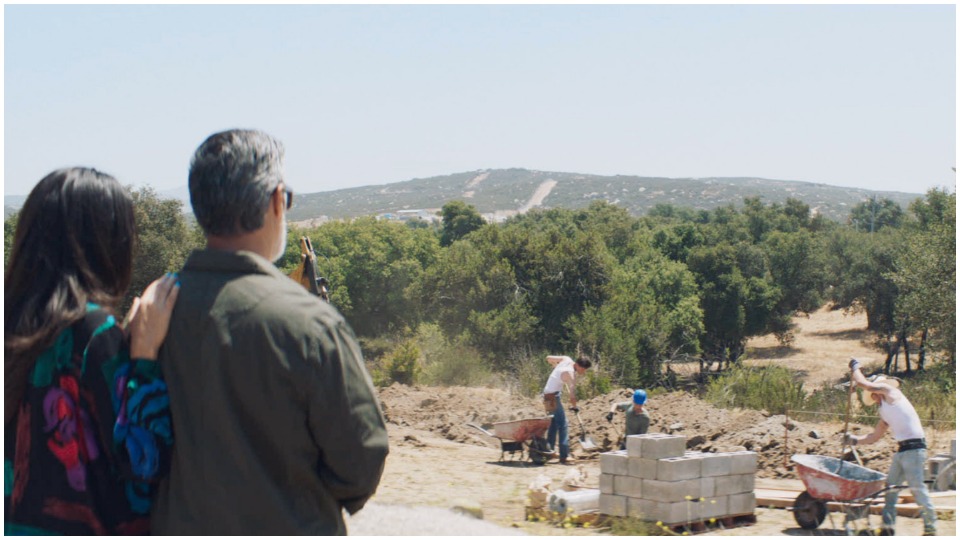
Virtually the entire action of this film takes place on the vast compound belonging to the Aristas, a Mexican-American family of unimaginable wealth and privilege. It has cattle, a vineyard, storied rose gardens, a home and outbuildings worthy of Architectural Digest, I didn’t get exactly where but I am guessing borderland California judging from license plates.
Although the most visible artifacts that the film consistently returns to are a well on the property and the cinderblock wall that the patriarch decides to build around the ranch, it’s the class relations on the compound and among the surrounding townsfolk in Winfield that are of the essence in the tale.
The overindulged daughters are given to drug use and wild, unsupervised parties, which allow for some visionary cinematography which may hold some viewers’ attention. Another cinematic gimmick is the use of montage and fantasy to depict the water of the well—where it comes from, where it leads, and what hallucinatory underwater effects can be extracted from this theme.
What no viewer should be able to miss, however, is the stupefying use of modern critical theory learned from professors and books, in a word, deconstructionism, to which the daughters have quite inexplicably attached themselves. At every turn they are spouting off pretentious Foucault-, Derrida- and Lacan-inspired pronouncements which ricochet between inanity and profundity, all in the service of an evil and far grander ruling-class scheme not so much to dominate the local water market but far beyond that, to control information, privacy and resources, and force people to pay for protection against fake videos that would compromise them, in a masterminded future only imaginable in the higher reaches of information media and right-wing think tanks. We cannot forget that Paul de Man, one of the world’s leading deconstructionist thinkers, had been, in fact, a fascist in his formative years.
Thus construction, in the literal sense, and deconstruction philosophy are put to complementary use in building a sad dystopia of division from and contempt for anyone and everyone of lesser social status than the beautiful people.
The hapless lead Don, a young worker hired on for the night-guard shift at the compound, is played by Jackson Rathbone. The family consists of the patrón Henry Arista played by the fine Esai Morales, his snooty wife Monica (Alex Meneses), and the two obnoxious daughters, Tania (Marisol Sacramento) and Ximena (Carmela Zumbado). A worthless, addle-headed hanger-on in the girls’ social circle is Cokestraw (Moises Arias). A senior status worker at the Arista compound, who mentors Don, is Mike (Xander Berkeley), and a cameo role as the town’s Mayor Ann Mason is taken by Mariel Hemingway.
Completed in 2019, and for the most part (ironically) filmed in Mexico, The Wall of Mexico is an allegory not so dissimilar to the Great Wall of China or any other bold attempt to isolate a people and culture from outside influences. Such attempts are rarely very effective on the long run, as much adapted to claustrophobically walling in people as to walling others out. In this case, it’s a wall being constructed around one family’s hacienda in California, a bit of a twist on the Trump idea of walling out all Mexicans and other immigrants at a fortified U.S.-Mexico border.
The film is directed by Magdalena Zyzak and Zachary Cotler (who also wrote the screenplay and composed the music). They must have loved Parasite, with its shifting sympathies for its ruling-class and working-class elements. But there is sadly much less subtlety here.
The Wall of Mexico is, in the end, not well constructed—something like those portions of the actual Trump wall that fell over in the first windstorm. Even the title is a little clumsy, as if it were a literal, not idiomatic translation from Spanish. There are way too many big themes that go astray, too many questions unanswered, a host of backgrounds to these characters unexplained (where did those airhead daughters learn all that hifalutin’ academic lingo anyway?). And why was that well water so special, that made it so distinct—and so marketable—from the regular county tap water? Maybe nothing at all, except for the fetishistic conceit that by definition private water simply has to be better than public—an almost universally accepted principle now, and guess who profits from that one?
I suppose it might have helped if the recorded sound level for conversations had been higher. It was hard to make out half the dialogue throughout much of this 110-minute work. Some phantasmagorical funhouse camera work and a couple of animalistic sex scenes could not save this film for me despite what I believe were its better intentions.
The trailer can be viewed here.
Over the next month it opens in virtual theaters, two or so per week. This week, it screens via Laemmle theaters, Los Angeles, accessible here, and at the Cleveland Cinematheque, here. On a national scale, the film will release Oct. 13 on VOD (iTunes, Google Play, Amazon, etc.).










